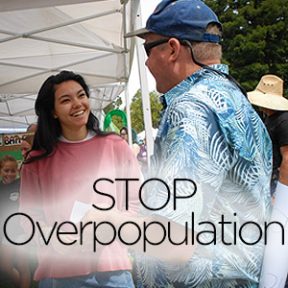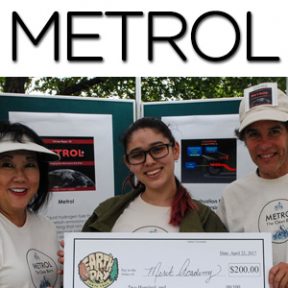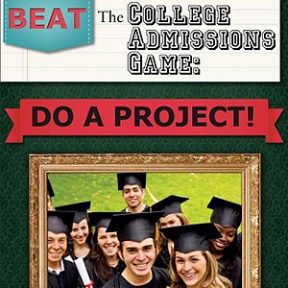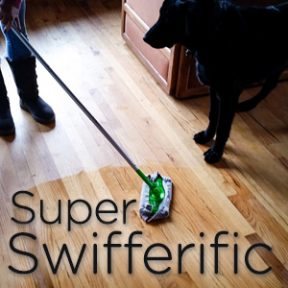 After announcing her plan to address overpopulation on KSCO radio a few weeks ago, Pascal joined the Merit Academy environmental science projects booth at Earth Day Santa Cruz to do her first event.
After announcing her plan to address overpopulation on KSCO radio a few weeks ago, Pascal joined the Merit Academy environmental science projects booth at Earth Day Santa Cruz to do her first event.
With her new message: THREE’S A CROWD!, Pascal is encouraging couples to have no more than 2 children.
The Climate marchers, UCSC students, and local Santa Cruz residents were 100% supportive. They signed her pledge list and promised to tell their families and friends to do the same. Besides, who can afford to raise 3 children and take care of their parents, too?
With over SEVEN BILLION people on this planet, she plans to make sure we don’t hit TEN BILLION!

 After announcing her plan to address overpopulation on KSCO radio a few weeks ago, Pascal joined the Merit Academy environmental science projects booth at Earth Day Santa Cruz to do her first event.
After announcing her plan to address overpopulation on KSCO radio a few weeks ago, Pascal joined the Merit Academy environmental science projects booth at Earth Day Santa Cruz to do her first event.
With her new message: THREE’S A CROWD!, Pascal is encouraging couples to have no more than 2 children.
The Climate marchers, UCSC students, and local Santa Cruz residents were 100% supportive. They signed her pledge list and promised to tell their families and friends to do the same. Besides, who can afford to raise 3 children and take care of their parents, too?
With over SEVEN BILLION people on this planet, she plans to make sure we don’t hit TEN BILLION!

 Sometimes the most obvious solutions are best discovered by our kids. At Earth Day Santa Cruz, Hannah Faris debuted her plan to reduce CO2. With ONE BILLION internal combustion engine (ICE) cars on the road worldwide, Hannah is proposing that we all convert our ICE cars so they can use either Metrol (liquid hydrogen and nitrogen) or gasoline (until there are Metrol pumps at every fueling station).
Sometimes the most obvious solutions are best discovered by our kids. At Earth Day Santa Cruz, Hannah Faris debuted her plan to reduce CO2. With ONE BILLION internal combustion engine (ICE) cars on the road worldwide, Hannah is proposing that we all convert our ICE cars so they can use either Metrol (liquid hydrogen and nitrogen) or gasoline (until there are Metrol pumps at every fueling station).
Makes sense! The earth is warming up and we’re fast approaching 2 degrees, and soon after 3 degrees – when life as we know it won’t exist anymore. And as much as electric cars and hydrogen fuel cell cars are wonderful solutions, realistically it’ll be 100 years before they replace every ICE car on the planet.
So what do we do with the ONE BILLION ICE CARS that are spewing CO2 every day? We convert them! By replacing spark plugs with Smart Plugs and adding a few minor devices to your existing engine, your cars will be able to use either Metrol or gasoline – with a flip of a switch! At the cost of just a few thousand dollars that could be financed so nobody would have to dip into their savings, this conversion could take place in just a few hours.
So what is Metrol? It’s a fuel that has net-negative emissions – which means that it actually cleans the air as you drive! The really amazing part is that it is made from anything that rots or burns. They take the methane and pull out the carbon to make hydrogen. This is where Metrol is different from biofuels. By adding nitrogen (and other proprietary ingredients) to hydrogen, it creates a liquid hydrogen that can be stored at room temperature. This is revolutionary.
Hannah is opening Kids 4 Hydrogen chapters across the US to share this amazing solution to our energy needs. She is just finishing a whiteboard video that will answers questions as she works with the developers to – well, save civilization. Join the movement: www.Kids4Hydrogen.org and sign the waitlist for conversions. It’s free and there’s no obligation.
We can’t rely on our government (don’t get me started!), corporate America, and even our own EPA. So, join Hannah and the youth as they stand up to the oligarchy that runs our nation and create an infrastructure that will reduce CO2!

 If ever we needed the community – and country – to gather to find environmental solutions, it’s now. Kids 4 Hydrogen will be there to debut Metrol and Smart Plugs. Come learn about this fuel that cleans the air as you drive! It’s made from anything that rots but it’s not a bio fuel because we remove the carbon – cool, right? No CO2! And, until the rest of the country (world) catches on, it’s also a flex fuel, which means that you can use gasoline with a flip of a switch!
If ever we needed the community – and country – to gather to find environmental solutions, it’s now. Kids 4 Hydrogen will be there to debut Metrol and Smart Plugs. Come learn about this fuel that cleans the air as you drive! It’s made from anything that rots but it’s not a bio fuel because we remove the carbon – cool, right? No CO2! And, until the rest of the country (world) catches on, it’s also a flex fuel, which means that you can use gasoline with a flip of a switch!
The best part is that you don’t have to buy a new car. You can convert your internal combustion engine (ICE) car by replacing your spark plugs with SMART PLUGS. Yup! The conversion takes about the same time it takes to tune up your car. Amazing. Come learn more about Metrol and Smart Plugs at our booth at Earth Day Santa Cruz. We’ll be at San Lorenzo Park from 11:00 am – 4:00 pm.
 Here’s another “GET YOUR HEAD OUT OF THE SAND” moment. Just because we had lots of rain this winter doesn’t mean that our drought is over and everything is back to normal.
Here’s another “GET YOUR HEAD OUT OF THE SAND” moment. Just because we had lots of rain this winter doesn’t mean that our drought is over and everything is back to normal.
2016 was the HOTTEST YEAR EVER RECORDED according to the World Meteorological Organization (WMO).
Global warming is a direct result of human activity and we have and will continue to see climate-related disasters.
Remember in 2016:
- Vanishing artic and polar sea ice
- Bleaching of the Great Barrier Reef
- Flash floods in the United Kingdom
- Droughts in India, Southern and Eastern Africa, and Central America
- Hurricane Matthew devastated Haiti
- Heavy rains and floods affected Eastern and Southern Asia
This year and every year will bring on more severe weather because our oceans are heating up which causes the ice caps to melt. Atmospheric carbon dioxide continues to rise because we keep spewing CO2 from our cars and factories.
Sign petitions, call your representatives, donate funds, march with the masses. It’s time to unite to save our civilization. We’re facing unprecedented climate-related catastrophes.
[Source]
 You’ve heard about the savants who can’t brush their teeth but can tell you the day of the week each of our presidents were born. It sounds ridiculous that a savant could memorize or calculate complex formulas in just seconds. While having this skill may seem enticing on first blush, unfortunately savants can’t do this with other more practical applications.
You’ve heard about the savants who can’t brush their teeth but can tell you the day of the week each of our presidents were born. It sounds ridiculous that a savant could memorize or calculate complex formulas in just seconds. While having this skill may seem enticing on first blush, unfortunately savants can’t do this with other more practical applications.
Martin Dresler, cognitive neuroscientist at Radboud University in the Netherlands, looked at the anatomy of memory champions to compare their brains to average people. One of the memory champions, Konrad, also co-authored this study. He uses visual memory to help him remember names. If a person’s name is “Miller,” he might visualize the person’s face looking at a “mill.”
For more abstract memory challenges, he builds “memory palaces” in his mind. By picturing a familiar place like your first home, he takes the list of numbers or objects and places them along the path through his house. If he were memorizing numbers, he might transform the numbers into images. Because these images would be personal, it would stand out along the path through his house.
Dresler and Konrad found that people who learned how to use the memory palace, could use that skill months later. While this is very interesting, it is not conclusive. There are many studies of people who have memorized the Bible or historical dates. When asked to memorize other things like a list of groceries or phone numbers, they perform just like everyone else. So far, these intense memory training programs don’t cure normal forgetfulness.
I find these studies to be fascinating. The more we discover about the way we learn and retain information, the better teachers we’ll be to our children and students. And, if we could find a way to improve memory for our aging population, that would bring relief to millions of people.
[Source]
 Worried about how your child will get into top colleges?
Worried about how your child will get into top colleges?
It still surprises me when my new teenaged clients tell ME what they need to do to impress college admissions officers. They come with their lists of AP classes, expensive summer camps, and all of the sports teams and clubs they belong to. I smile and nod as they tell me about all of the “hard work” and how they’re “so busy” they don’t have time for anything else. When they’re done with their monologues — and feeling quite accomplished with themselves, I honestly can’t remember one thing they did that made them stand out amongst the other millions of kids vying for those coveted acceptances to the top colleges in the US. And that’s why their plan doesn’t work.
When everyone across this nation takes the same AP or IB classes on the exact same day each year, and they’re all taking SAT/ACT prep classes to artificially inflate their scores, perfect GPAs and SATs don’t guarantee admission into selective colleges because these students don’t stand out. So what do you need to do to get into top universities?
Do a PROJECT.
Yup, it’s as simple, and yet as difficult as that. Forget all the AP classes, starting or joining dozens of clubs, and dedicating ridiculous hours for practices and rehearsals. If everyone is doing them, unless you’re the MVP or you’re winning Academy Awards, it sounds like busy work – because it is.
Here’s what you need to do:
1.Choose a project
Spend time brainstorming before moving forward. Think about issues that need to be fixed, applications that need to be written, and books that need to be published. It really doesn’t matter what it is as long as you’re fascinated and passionate about it.
2.Delve into it
Research what others are doing about your idea to determine whether or not there’s room for you. Find your niche and create your brand. Then, get the word out and grow your idea or market your product. Make calls. Be persistent. Don’t give up.
3.Realize your goal
Every step you take will get you closer to your goal. For every student I guide, I watch doors open for them because of their persistence and their eye on the goal. They get invited to speak at conferences or on TV/radio. Success begets success. They accomplish their goals.
Students who do projects have fascinating stories to tell on their college admissions essays. Nobody wants to read about your team spirit or how grateful you felt after you went to an elite summer program. Instead you’ll captivate admissions officers by telling them about overcoming the inevitable obstacles you had faced when developing an app or trying to talk to the governor. When they read about how you protected the weak or started a non-profit organization to stand up to corruption, you’ll have their undivided attention.
Colleges don’t want robotic students who are good at memorizing facts, take overwhelming AP classes and spend all their free time at practices working under coaches or directors. These types of students will not be our future leaders of innovation or the world. Instead, admissions officers want interesting students who find solutions to problems and have unwavering drive to reach their goals.
Naturally, these projects must be done by the student – not their parents. If you need help with starting a project, check out my book Beat the College Admissions Game: Do a Project! or if you need support, meet with me at one of my offices or on Skype. The ideal time to start a project is in 8th or 9th grade so you have time to develop amazing ideas. But, I work with juniors who develop their projects just in time for applications in 12th grade.
It’s time – DO A PROJECT!
 It’s exciting to see that expecting parents are ditching the traditional cribs in favor of baby boxes here in the United States. I blogged about how Finnish hospitals give baby boxes stuffed with all kinds of supplies for newborn babies to families when they leave the hospital to reduce Sudden Infant Death Syndrome (SIDS). New Jersey has become the first state to adopt the baby box program. They’re set to distribute over 100,000 baby boxes. Ohio is following suit and hospitals in Philadelphia and San Antonio are giving them away too.
It’s exciting to see that expecting parents are ditching the traditional cribs in favor of baby boxes here in the United States. I blogged about how Finnish hospitals give baby boxes stuffed with all kinds of supplies for newborn babies to families when they leave the hospital to reduce Sudden Infant Death Syndrome (SIDS). New Jersey has become the first state to adopt the baby box program. They’re set to distribute over 100,000 baby boxes. Ohio is following suit and hospitals in Philadelphia and San Antonio are giving them away too.
To prevent infant mortality, parents are discouraged from sleeping with their child or putting toys in their cribs. These baby boxes are lightweight and portable so infants can sleep near their parents. The baby boxes also come with an educational video for new parents to learn about how to prevent SIDS.
In 2015, 3,700 infants in the US died from SIDS. In Finland they started using baby boxes in 1949, and the infant mortality rate dropped from 65 deaths per 1,000 infants in the 1930s to just 3.5 deaths in 1949. Our infant mortality rate is double Finland’s; in 2016, we had 5.8 deaths per 1,000 births.
The other benefit of using baby boxes is reducing the pressure on parents to spend hundreds of dollars on unnecessary baby furniture that babies outgrow so quickly.
[Source]
 Getting ready for Easter Egg hunts and games – yes, with my adult children (Jaclyn and friends), and dogs!
Getting ready for Easter Egg hunts and games – yes, with my adult children (Jaclyn and friends), and dogs!
This year I designed an Easter Village using Rice Krispies and pretzels for structures and landscaping.
I had so much fun, I could have built an entire city!
Already have ideas for my next Rice Krispies project!

 I like clean hardwood floors, but with 2 giant puppies that roll around the hillside and bring in what seems like piles of dirt, it’s impossible to keep the floors clean for long. I’ve tried every kind of mop on the market and they’re either cumbersome to use or they require disposable pads that go against my environmental philosophy.
I like clean hardwood floors, but with 2 giant puppies that roll around the hillside and bring in what seems like piles of dirt, it’s impossible to keep the floors clean for long. I’ve tried every kind of mop on the market and they’re either cumbersome to use or they require disposable pads that go against my environmental philosophy.
Considering that I need to mop a couple times a day, I preferred the Swiffer because it is lightweight and easy to use – don’t need any heavy buckets. But, the ridiculous design requires you to throw away your Swiffer sheet after each use! I refused to succumb to adding more waste to the landfill and lining Proctor & Gamble with weekly repeat sales. Replacement sheets cost about .25. For me, that would be $180/year!
My solution = use reusable sheets!
By cutting up a couple of old towels and sheets, I have a month’s supply of sheets that I can reuse for years! It didn’t cost me a penny and they actually work better than the Swiffer sheets! My “new” old towel sheets are heavier so they pick up sand and debris, and they clean up spills in a jiff!
I’m so excited to have solved my Swiffer dilemma that I have made reusable sheets for my girls too! Not sure they’ll be as excited as I am, but I’m glad that we’ll all be sending a little less to the landfills and saving a few dollars.


 “Go West Young Man” (but it’s not the “west” you’re thinking of…)
When I first saw images of high-rise buildings with thousands of miles of roads in the middle of what looked like an arid desert in nowheresville China, it felt like eerie – even creepy – as I wondered why China would build huge cities that have no residents. No people lived there. That was in 2012 when urban planners of China’s Communist party decided to expand urbanization far in the western part of their nation. They called the Lanzhou New Area.
To build this metropolis, they leveled hundreds of mountains (the greatest mountain-moving project on earth) in an area infamous for contaminated air, water, and soil – hmm, what could possibly go wrong?
The plan was to bring one million people to live, work, and prosper in a free-trade zone. They built replicas of the Great Sphinx, the Parthenon, and even the Great Wall to lure tourists and would-be residents. They even put in an artificial lake. This kind of reminds me of Las Vegas (building high-energy consumption resorts in the middle of the desert). The Chinese government claims that the Lanzhou New Area will be able to house 3.4 billion people. Unfortunately, people aren’t flocking there, and these cities are now called “Ghost Cities.” A few people – mostly those who were forced to leave the villages that were wiped out when they developed the area – have moved into some of the buildings, but they complain that they don’t have jobs.
My guess is that the Lanzhou New Area will become a bustling economic center in the future because of the rising population and choking pollution in the major cities in China (including the Lanzhou “Old Area” 40 miles south). I wonder when people will make the move, and will they need to rebuild the infrastructure after buildings have been vacant for long periods of time? Check out this article for pictures of this “ghost city”.
“Go West Young Man” (but it’s not the “west” you’re thinking of…)
When I first saw images of high-rise buildings with thousands of miles of roads in the middle of what looked like an arid desert in nowheresville China, it felt like eerie – even creepy – as I wondered why China would build huge cities that have no residents. No people lived there. That was in 2012 when urban planners of China’s Communist party decided to expand urbanization far in the western part of their nation. They called the Lanzhou New Area.
To build this metropolis, they leveled hundreds of mountains (the greatest mountain-moving project on earth) in an area infamous for contaminated air, water, and soil – hmm, what could possibly go wrong?
The plan was to bring one million people to live, work, and prosper in a free-trade zone. They built replicas of the Great Sphinx, the Parthenon, and even the Great Wall to lure tourists and would-be residents. They even put in an artificial lake. This kind of reminds me of Las Vegas (building high-energy consumption resorts in the middle of the desert). The Chinese government claims that the Lanzhou New Area will be able to house 3.4 billion people. Unfortunately, people aren’t flocking there, and these cities are now called “Ghost Cities.” A few people – mostly those who were forced to leave the villages that were wiped out when they developed the area – have moved into some of the buildings, but they complain that they don’t have jobs.
My guess is that the Lanzhou New Area will become a bustling economic center in the future because of the rising population and choking pollution in the major cities in China (including the Lanzhou “Old Area” 40 miles south). I wonder when people will make the move, and will they need to rebuild the infrastructure after buildings have been vacant for long periods of time? Check out this article for pictures of this “ghost city”.










